You're probably looking at this pair of MPVs parked next to one another and thinking, “Time for another famous Autocar India comparison test.” Well, not quite. You see, this isn't a straightforward head-to head; it can’t be. Because while the Toyota Innova is a very premium MPV, the Kia Carnival has taken things a step further. In fact, where the Crysta’s price range ends is where the Carnival’s begins; and the top-spec versions you see here are over Rs 10 lakh apart. So really, they belong to two entirely different segments.
So then, why are we here? It’s simple. The Innova’s steady march up the price ladder since its launch in 2005 (it’s more than doubled in price, and that’s not just inflation) has proven that when you get your core values just right and make a strong name for yourself, Indians won’t mind paying a premium.
The Carnival looks to take that idea and run with it even further – and without a legacy of its own, but rather, on the back of the immensely positive response to brand Kia and the blockbuster that is the Seltos. Sure, the Carnival doesn’t sell in anywhere near the same numbers as the Innova (and probably never will), but it has managed to carve out a small niche for itself at an even higher price point.
So we’re going to try and figure out just what these two offer over your common or garden variety people mover, and what exactly it is you get for the not-inconsiderable price tags that they command.
The People's Champion
Let’s start from behind the wheel, and in the Innova Crysta, it’s not hard to see why so many people love it so much. It shares its body-on-frame platform with its big brother, the Fortuner; and what you get is a similar, high-set, SUV-like driving position that lets you tower over all and sundry.
It’s also not hard to see why it’s gotten so expensive, as the interior is a quantum leap over the drab old cabin of the first Innova. It’s got curves and layers and a sort-of free-standing centre console, as well as a nice velvet receptacle for your elbow in the door pads.
The wood trimming on the dash is quite convincing, though I’m not as convinced by the same trimming on the steering wheel; it just makes it harder to grip. And though plastic quality is hard-wearing and good, I’d have liked some soft-touch materials at this price point.
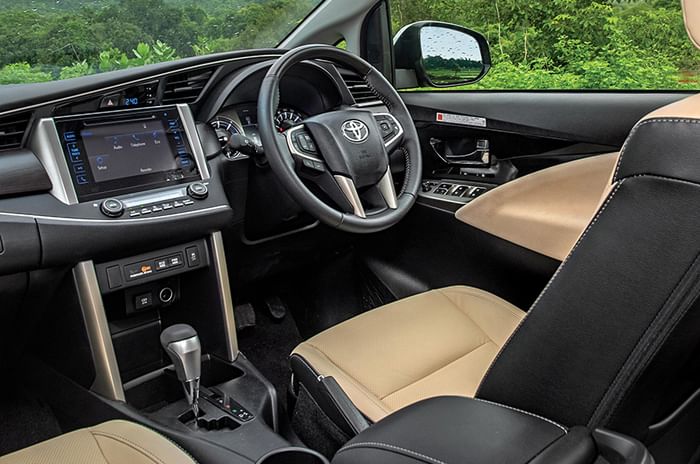
The SUV-like seating position may feel good, but the SUV-like driving experience is a mixed bag. The hydraulic steering is heavy and kicks back hard (grip the wheel at the sides not on the wood trim) if you go through a pothole too fast. But then you don’t mind driving through potholes fast, because its tough, body-on-frame layout gives it great ground clearance, and lets you mow down bad roads with reckless abandon. Moreover, and this is likely the main reason most people love the Innova, it stays incredibly planted on the highway with a full complement of passengers.
And that’s just the thing – some might scoff at the idea of paying upwards of Rs 20 lakh for an MPV with a utilitarian ladder-frame chassis and slightly gruff diesel engine with rear-wheel drive that have their roots in a pick-up truck; but this formula is perfect for moving heavy loads, especially over rough roads and in hilly conditions.
Gruff though the diesel engine may be, it’s tuned with hauling in mind. This is the new BS6 version with the 6-speed auto, and the pair are well matched. With all the torque focused low down, it leaps off the line at the slightest tap, and the gearbox does a pretty good job of deciphering when you need revs, or when you just want to cruise.
From The Flight Deck
The immediate sense you get, stepping into the Carnival after the Innova, is ‘more’. You realise just how much wider it is than the Innova by how effectively the vast central console separates you from your co-driver. The HVAC and audio controls are spread out the hooded instrument binnacle is huge, and even the cupholders are massive.
Where the Innova’s dash hides a utilitarian structure behind clever design, the Kia’s is more conventional and like what you’ll find in an executive sedan or crossover. Personally, I find the look a little uninteresting and dated, but there’s no question that quality levels are a notch higher than the Innova. The top of the dash is all soft-touch plastic, and even the switchgear feels that little bit better finished.
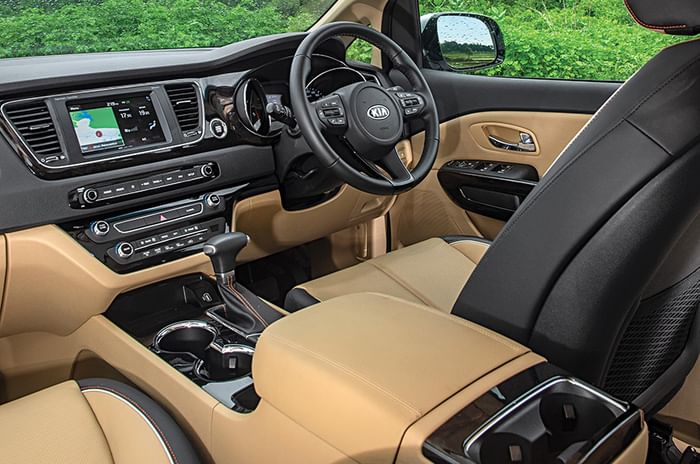
It’s immediately apparent how big the Carnival is from behind the wheel; but even though it doesn’t have the Innova’s high-set seat, forward visibility is good and helps you come to terms with its mass quite easily. Also helping this is the light and effortless steering, and though the Innova has the slightly tighter turning circle, taking U-turns in the Carnival is much less work.
A bigger car needs more power, and though the Carnival’s 2.2-litre diesel is of a lower capacity, it makes 200hp and 440Nm of torque – a full 50hp and 80Nm more than the Crysta! It’s nowhere near as responsive at low revs as the Toyota; in fact, it can feel a little overwhelmed if the car is loaded up. But once you get it into and beyond its mid-range, you can feel all that performance come in very strong. It’s also significantly more refined than the Toyota.
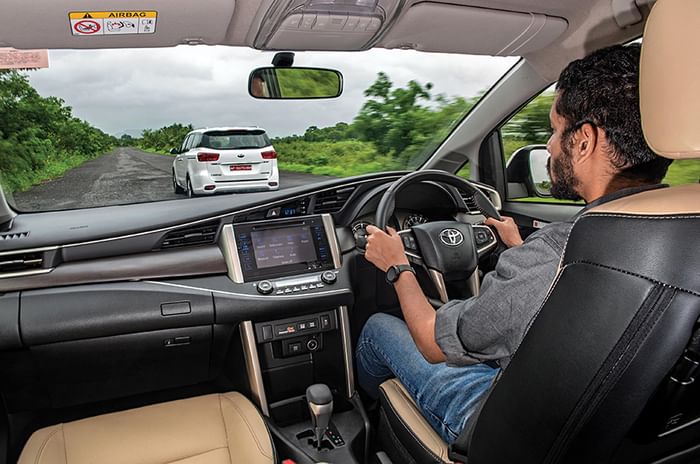
The Kia’s FWD and monocoque layout means it doesn’t feel quite as tough and hardy as the Innova, but it still makes for a composed highway cruiser. Low-speed ride, on the other hand, is softer and far more absorbent, and you don’t get moved around as much in the cabin. Though those shiny 18-inch wheels are big, the chunky 235/60 R18 tyres they’re wrapped in dwarf the wheels on the Crysta, and keep you well protected from the road. You might be a little concerned about the lower ground clearance and long 3,060mm wheelbase going over serious potholes or truck-stopping speed-breakers, but despite encountering both on our drive, we never saw it bottom out once.
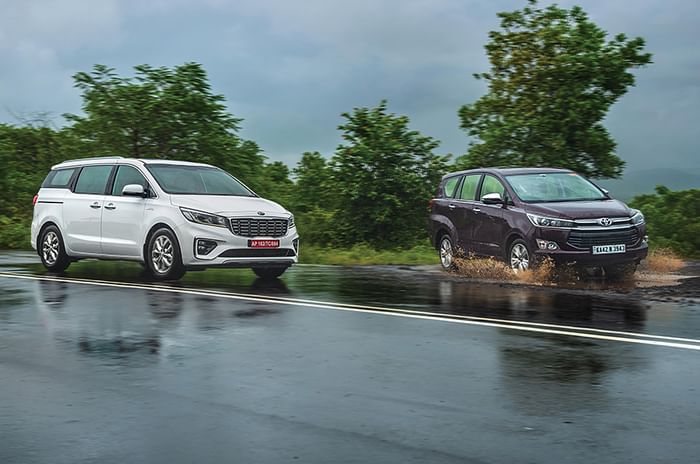
Space Ships
While newer, smaller MPVs have pulled off great feats of space-efficiency lately, the Innova has always been the go-to vehicle for proper 7-seat people-carrying capacity. Toyota goes so far as calling it an 8-seater if you choose the middle-row bench option, and yes, the third row can take three kids comfortably, or even three adults on short journeys. It’s place at a good height, so you’re not sat completely knees-up, and there’s more space back here than even some bulky 7-seat SUVs. Getting there is easy too. Sure, there’s a slight step up into the cabin, but even the captain’s chairs in the middle row tumble and flip forward at the pull of one lever.
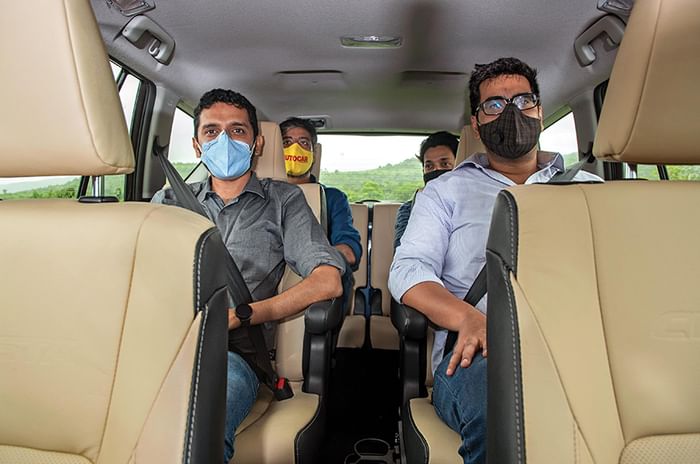
The chairs themselves are really great – wide, and with the ability to slide back-and-forth and recline. The only thing is that when you do recline the backrest, the armrest reclines with it, making for an awkward posture. Also, the seat-belt buckle is located in the seat base, so you’ll find yourself reaching under your thighs to fasten it, and though there are tray tables built into the backs of the front seats, they’re too small for a laptop; probably best used to keep a snack and a drink, at most. In fact, if you’re being chauffeur-driven, forget the table and slide the front passenger seat forward for more leg room, which can be done with one pull of the lever on its shoulder.
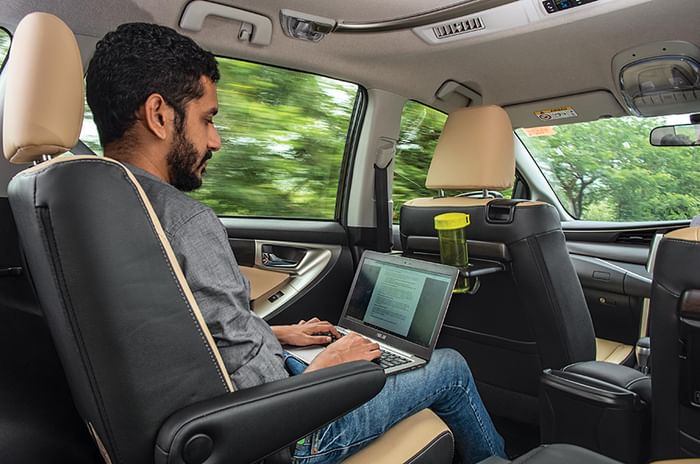
Once again, it’s a case of ‘more is more’ with the Carnival, and it starts before you even get in. The powered sliding door whirrs open, revealing a wide aperture for you to walk through. You can have the big Kia in three seating configurations – with as many as four rows and nine seats – but this top-flight ‘Limousine’ variant has seven seats. With fewer seats comes a lot more space, and the huge, comfy captain’s chairs in the second row are on another level; not only do they slide back and forth, and recline, they also slide side-to-side, so you can move away from the person next to you for maximum ‘social distancing’. And for that extra slice of the Business Class life, an ottoman folds out for you to rest your legs on.
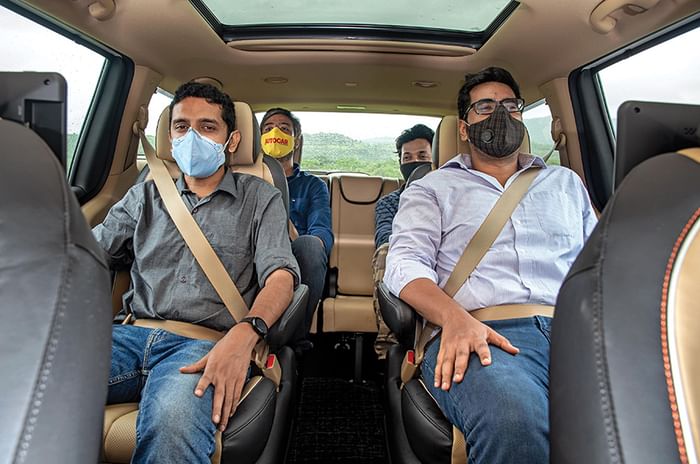
Where the Innova Crysta does without a sunroof, the Carnival has two, with the second one placed perfectly above the second row for a spot of stargazing with the seats reclined. Oddly, the Kia’s rear AC controls are placed in the roof behind the driver’s seat, making them hard to access if you’re sat on the left; meanwhile, the Innova’s controls are much better located in the centre of the roof. And while you don’t get tray tables or the facility to slide forward the front passenger seat in the Kia, there’s something much better – a pair of rear entertainment screens. These superbly executed 10.1-inch units are touch-sensitive, and allow for a variety of media inputs, like HDMI, AV-in, USB, and even screen mirroring of your smartphone.
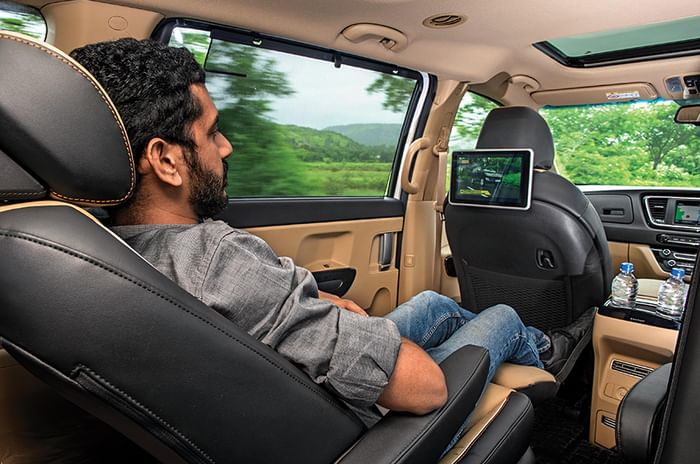
The third row is certainly wider than the one in the Crysta and can accommodate three with greater ease; but it’s not as comfortable.
You sit lower and a bit more knees-up, and despite this, headroom is a bit less than in the Toyota due to the lower roof; taller passengers will have to slouch a bit. Moreover, the Carnival Limousine’s big middle-row seats don’t tumble forward like the Crysta’s, and while you can pull all the levers and position it for better access, we found it easier to just walk between the two chairs to get to the third row.
Again, the Innova Crysta can pull off what most smaller MPVs can’t, and that is taking 2-3 big suitcases, standing up, in its boot, with all three rows up. But you guessed it, the Carnival can go one better. Not only can it take four big suitcases standing up, there’s enough room to stack four more on top of it. This is possible because the spare wheel is placed under the middle of the car, not the rear, and this frees up a huge cavity in the floor that you drop your luggage into.
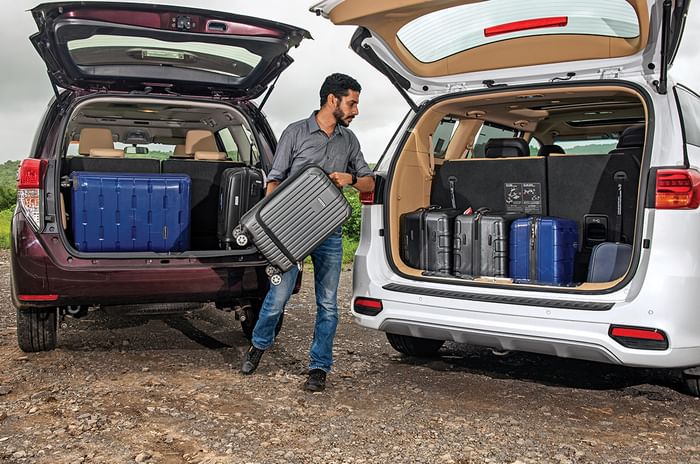
A quick word on equipment, and here too, the Kia really makes you feel like you’re getting your money’s worth. Apart from the aforementioned screens and sunroofs, the highlights include a powered and ventilated driver’s seat, three-zone climate control, full- LED headlamps, a powered tailgate with remote operation, wireless phone charging, a Harman Kardon sound system, an air purifier, and a touchscreen infotainment system with Apple CarPlay, Android Auto and Kia’s ‘UVO’ connected-car suite which lets you do all sorts of things, including starting the car remotely. The Innova feels a little disappointing in comparison, as while it gets stuff like auto climate control, auto-LED headlamps, push-button start and a powered driver’s seat, there’s not much else of note. The touchscreen feels very old and doesn’t even give you smartphone connectivity.
| Equipment | ||
|---|---|---|
| Kia Carnival Limousine | Toyota Innova Crysta 2.4D ZX AT | |
| Auto climate control | 3-zone | 2-zone |
| Touchscreen | 8.0-inch | 7.0-inch |
| Apple Carplay/Android Auto | Available | NA |
| Connected car tech | Available | NA |
| Wireless phone charging | Available | NA |
| Ventilated seats | Driver | NA |
| Powered front seats | Driver | Driver |
| Powered tailgate | Available | |
| Rear-view camera | Available | Available |
| Parking sensors (F/R) | Available/ Available | NA/ Available |
| Rear entertainment screens | Available | NA |
| Sunroof | 2 | NA |
| Push-button start | Available | Available |
| Middle-row tray tables | NA | Available |
| Airbags | 6 | 7 |
The Van With The Plan
Like we said at the start, this isn’t a straightforward comparison, and we won’t be picking a winner. In fact, though the Innova has some key advantages, it’s clear the Carnival is the superior vehicle here; but of course, you pay for this superiority too. No, what’s more important is that both of them prove that MPVs needn’t be basic, and they take slightly different routes to justify their higher price tags.
The Innova is a bit more old-school, winning you over with its tough underpinnings, workhorse of an engine and, above all else, Toyota’s legendary reliability. It’s a car you feel you’ll never have to sell, and one you can hammer through the worst conditions with absolute peace of mind. The Carnival hasn’t quite proven its longevity yet, and instead sells you on being a premium commodity. It’s big, it’s plush, it’s comfortable, it’s loaded with gizmos, and if this sort of thing meets your requirements better than frequent trips to a battered hill station, maybe it’s worth making the stretch.
Whatever the case, though they’ll likely never overtake SUVs as the popular body style for a family car, it’s good to see a bit of diversity in the MPV space for those who want it. They’re still the best way to move seven people in comfort
| Technical Specifications | ||
|---|---|---|
| Kia Carnival Limousine | Toyota Innova Crysta 2.4D ZX AT | |
| Length | 5115mm | 4735mm |
| Width | 1985mm | 1830mm |
| Height | 1740mm | 1795mm |
| Wheelbase | 3060mm | 2750mm |
| Engine | 4-cyl, 2199cc, turbo-diesel | 4-cyl, 2393cc, turbo-diesel |
| Power | 200hp at 3800rpm | 150hp at 3400rpm |
| Torque | 440Nm at 1500-2750rpm | 360Nm at 1400-2600rpm |
| Gearbox | 8-speed automatic | 6-speed automatic |
| Price (ex-showroom, Delhi) | Rs 33.95 lakh | Rs 23.63 lakh |




























